Menu
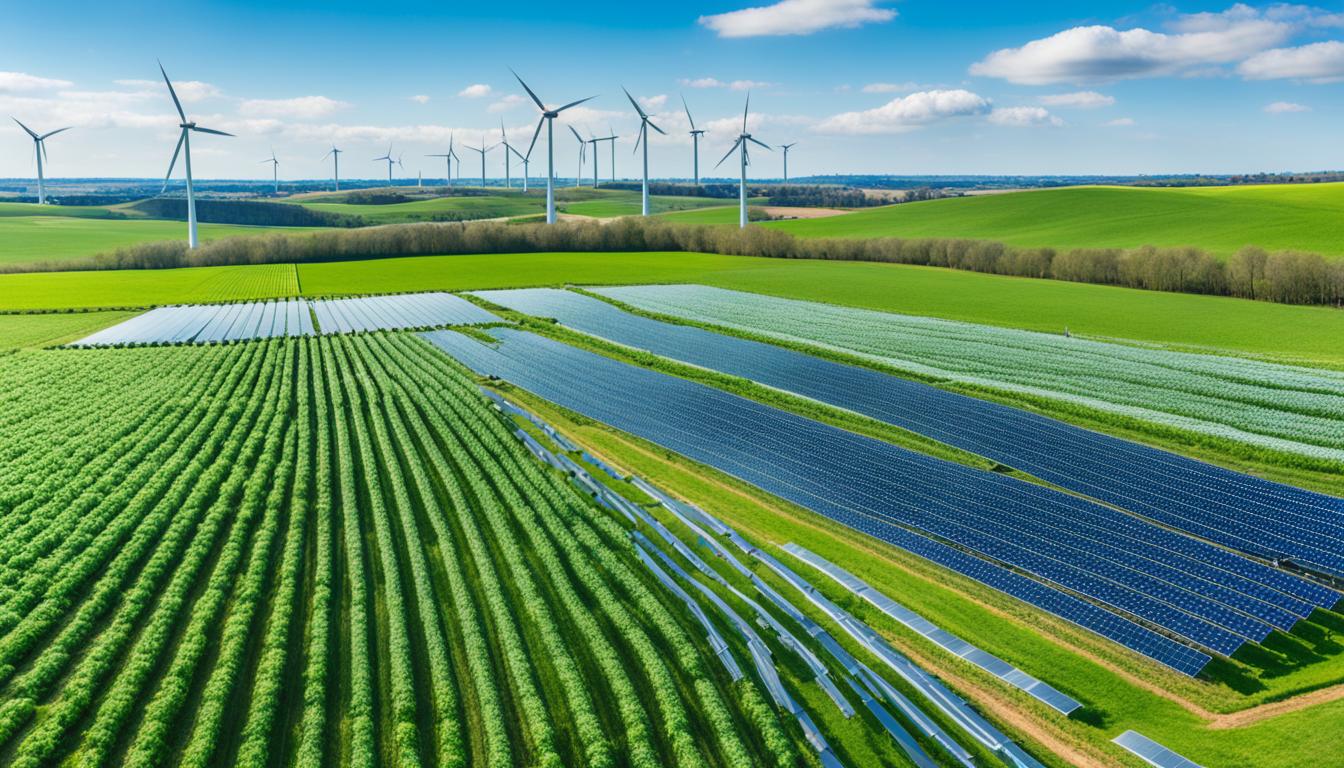
In 2016, the world used over 700 million hectares for growing staple grains. This area covered about half of all the farmable land. It shows us how huge a role agriculture plays. But, it also means a big environmental footprint. For instance, farming uses 70 percent of the Earth’s available freshwater. Experts believe we will need 15 percent more water for farming by 2050.
Farming more to feed everyone has hurt the environment. Livestock overgrazing creates a lot of greenhouse gases. This leads to land getting badly damaged. Also, China makes a lot of nitrogen fertiliser. This has caused a big jump in environmental nitrogen. Half of this nitrogen escapes into the soil, air, and water, causing pollution and hurting aquatic life.
It’s now crucial to find a balance in agriculture that both feeds us and keeps the planet healthy. This balance is important for food security and the environment. So, global policies are needed. They should help farmers use eco-friendly ways. These methods should lower the damage to our planet while keeping farms productive.
For a deeper dive into the environmental impact of agricultural modifications, read more here.
Global environmental policies greatly influence how local farming works. They push for more sustainable ways of farming. These rules are key in fighting bad ecological effects and aiming for farming methods that help the environment.
Over the years, how we farm has changed a lot. This is because we care more about the environment and there are stricter rules for farming. For example, in sub-Saharan Africa, many people were not getting enough to eat in the mid-1980s. They used a lot of harmful chemicals to grow crops, which was bad for the earth. But, this caused more problems, like making a lot of greenhouse gases. These gases are 26% of what farms worldwide make. So, things had to change.
Thanks to global environmental rules, new farming technologies are being used. These help make farming better for the earth. For example, precision farming lets farmers use water and nutrients more carefully. This saves important resources and keeps soil healthy. This change is very important since farming uses 70% of the world’s fresh water. Also, it causes 78% of water pollution. So, using new and better ways to farm aims to help farms be more ecological while still being productive.
| Region | Malnourished Population (Mid-1980s) |
|---|---|
| Sub-Saharan Africa | 35% |
| Asia | 22% |
| Developing Market Economies | 22% |
With almost 8 billion people by 2050, we’ll need 70% more food. Sustainable farming is key. It lets us grow enough food while protecting the environment. Methods like rotating crops and using organic farming keep our soil and nature healthy.

Changing the crops we grow each season is vital. This is what crop rotation is about. It boosts the land’s nutrients naturally, cutting the need for chemicals. Plus, it confuses pests, reducing pesticide use.
“By cultivating different crops, farmers improve the land and make farming more resilient.”
Organic farming avoids man-made chemicals. It focuses on nature-friendly ways to grow crops. This supports wildlife and helps the environment. It’s part of the world’s move to farm in ways that are good for people and the planet.
To sum up, methods like crop rotation and organic farming are essential. They meet food needs while protecting our world. By choosing these, we’re making food production better for everyone and the Earth.
Modern agriculture focuses on being eco-friendly. It aims for a healthy balance between producing food and taking care of the planet. One big step is using no-till or reduced-till methods. These methods stop erosion and keep the soil healthy. They work by not disturbing the soil much, which helps it hold water better and keeps more organic matter in it.
Planting cover crops such as clover and rye in between main crops is also key. This helps to stop erosion and control weeds without harmful chemicals. It shows how farming can be good for the earth and use fewer pesticides.
Using crop diversity practices is another smart move. This means planting different crops together or changing them every few years. It helps with pest control and keeps the soil in great shape. So, farmers who mix up their crops have less trouble with pests and can grow crops well over time.
Integrated pest management (IPM) is critical too. It means taking a smarter approach to dealing with pests. By using different methods instead of just chemicals, farmers can keep their crops safe and the environment healthy.
Agroforestry practices add even more benefits. This is about planting trees and bushes in farm fields. It helps protect water and gives farmers more to sell, like fruits and nuts. These practices are all about making farming more varied and kind to the planet.
Bringing animals into farming can also make a big difference. Livestock can fertilise the soil naturally. This helps crops grow better. So, farming with animals can be good for the earth and make more money for farmers.
Not using some areas of the farm can also be helpful. These uncultivated spots play a big role in stopping soil erosion and keeping the water clean. They also are good for wildlife. So, these areas are important for keeping farms sustainable.
The agricultural community is worried about the rules from the Environmental Protection Agency (EPA) for farming. They say the EPA’s rules are expensive and hard to follow. This is even though many traditional farms and ranches don’t have to follow all the rules. The EPA does still make laws that cover things like air, water, energy, and pesticides.
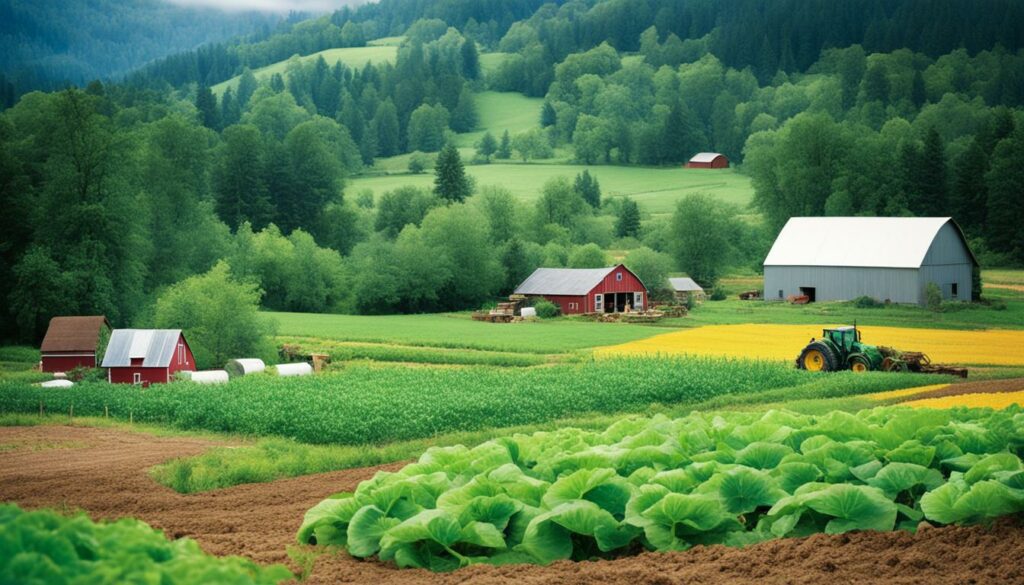
Issues with water quality are a big deal in farming. This is because farms might release bad stuff like sediment, nutrients, or pesticides. So, the government is mostly looking at big animal feeding operations for regulations. They’re also trying to make rules better for everyone, especially after people got mad about a water protection rule.
Laws on how much water farms can use are meant to cut down on waste. Making water use more efficient is really important for farms. For instance, the farming world is taking a closer look at using plants like corn to make fuel. But, this kind of biofuel hugely needs water to grow.
Looking after the soil is key for farming that can keep going for a long time. This means stopping the soil from washing away and keeping it healthy. The Conservation Reserve Program (CRP) paid farmers a lot of money in 2005 to leave land unused. This was a big move to protect the soil.
When farms change hands or what they grow, the soil usually isn’t as good as before. And some changes in how farms are insured have made things worse for some lands. This is a tricky topic because we need to use the land to make food but also make sure it stays good for farming in the future.
The effect of climate change policies on local farming is clearer as temperatures rise. In the past 115 years, the Earth’s average surface air temperature has gone up by about 1.8°F (1.0°C). This increase is affecting farming a lot, making it important for farmers to change how they work to deal with hot spells and floods.
Adapting to heatwaves is vital for farmers now. When the temperature rises a lot, it can be hard for crops and animals. They’re changing when they plant and using strong plants that don’t need much water. These changes also help to lower the greenhouse gases that harmful to our planet. The farming sector in the U.S. created a carbon footprint of around 671.5 million metric tons in 2021.
Staying safe from floods is just as crucial. Rain is changing in different ways across the U.S. This has led to more floods in some areas. Farmers are now using better water systems, flood walls, and drainage to protect their land. These methods not only help keep farms safe but also protect the land from damage. It’s important for farming to stay sustainable.
Farmers are now making big changes because of climate policies. They’re ready to fight the tough weather ahead by planning for heatwaves and floods. These steps help keep farms healthy and the environment strong.
Sustainable agriculture initiatives are key in modern farming. They make sure we meet food needs, help the environment, and are economically sound. These efforts are defined in the U.S. Code, helping farmers and society live a good life.

Renewable energy plays a big role in sustainable farming. Farms using solar, wind, and other types decrease their environmental impact. This leads to better energy use. Such energy can run pumps, greenhouses, and other farm tasks. It also supports clean energy goals worldwide.
Managing waste properly on farms is very important. Actions like composting, recycling, and managing manure help a lot. They cut down on the harm to the environment. Good waste handling also makes soil better, lowers emissions, and makes farms more sustainable.
Global environmental policies impact local farming, encouraging eco-friendly practices and cautious use of resources. Around 6,124 green rules were set by over 200 countries from 1960 to 2022. These guidelines, shaped by the European Union, aim to control fertiliser use, protect forests, and support varied life.
These guidelines have cut soil erosion by 43% worldwide. Most of the rules are ‘command and control’, meaning they are laws and regulations. The amount of these rules keeps growing, showing their increasing place in global issues.
Companies like Pernod Ricard show how these rules matter. They operate sustainably, covering over 5,000 hectares of vineyards across the globe. By following green farming methods, they boost their productivity while protecting the environment.
Pernod Ricard tackles climate change at every product stage, lowering CO2 emissions. Since 2010, they’re part of a UN initiative aiming to protect clean water. They work on using water carefully and treating wastewater to save resources.
They’re also keen on regenerative farming, aiming to increase biodiversity and trap carbon. Aligning with these practices benefits local food rules and the planet. It boosts both farming community life and global ecosystems.
Countries measure how well they’re doing by looking at their rules’ strictness and how well they’re followed. There’s a strong link (0.86) between how many rules a place has and how well they work. It shows that making and keeping to good laws is key to helping the environment.
In recent years, the making of local food production guidelines has changed a lot. It’s now more linked with worldwide efforts to protect the environment. These guidelines focus on sustainability practices. These practices are key for the future of farming.
The world is talking more about local versus global food. This talk has grown because of recent challenges. It’s hard to say which type of food system is better when facing problems. Problems like losing natural resources or not having enough food. Both local and global ways of producing food have their own good and bad points.
The biggest plus of local food systems is their resilience. Their ability to deal with changes and keep their main qualities is amazing. Adding this resilience to how we make and get food is crucial. It helps us tackle big issues and promotes food that’s good for the planet, healthy, and fair to all.
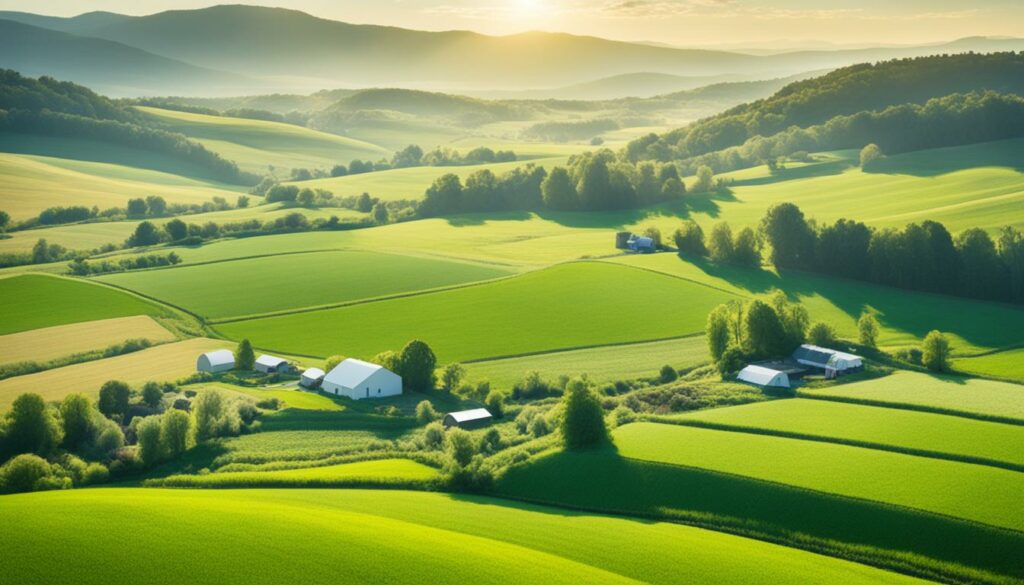
Sometimes, people think local farming is always better for the planet. But being close to where food is eaten doesn’t always mean it’s good for nature. So, rules for how farmers should work are vital. These rules focus on important things like saving water and protecting the soil.
The 2018 Farm Act in the US shows how important local food is. It has rules that help local food and also protect the environment. This Act makes sure local ways of farming are good for the earth and make sense financially.
But only focusing on local food can cause problems, like not having enough to go around. Finding the right mix of local and global food takes careful thinking. New ways, like selling food online, can make local food stronger. This has been very important during the COVID-19 outbreak.
A big issue in food guidelines is cutting down on transport’s harm to the environment. Even though moving food is only a small part of the problem, every little bit of help counts. Working on making food transport greener is a big step towards a healthier planet.
To sum up, having local food production guidelines that follow global environmental policies is key. Along with strict environmental regulations for farming, they help make food systems that are strong, good for the planet, and successful locally.
Green farming rules are crucial for sustainable agriculture. They aim to blend protecting the environment with keeping farms productive. These rules help farmers use both land and resources efficiently without harming nature.
Paying less importance to chemicals is key in green farming. Too many synthetics harm the earth, polluting soil and water. Around the world, lots of laws focus on using fewer chemicals. They push for farming in ways that are kind to the planet.
These rules also help keep our world’s plant and animal variety safe. They make sure different habitats and life forms can continue to thrive. Saving biodiversity means healthier lands for farming and a strong balance in nature. Many laws across Europe support this effort. They help farm practices protect, not harm, natural diversity.
Green farming guidelines underline the importance of less chemical use and saving biodiversity. By following these rules, farmers help in making the environment better while keeping their farms productive. This aligns local farm actions with what the world needs for a greener future.
Livestock farming has a huge impact on our planet. It uses a lot of water and land. Also, it’s a major source of greenhouse gases. We must tackle these issues for farming to be sustainable.
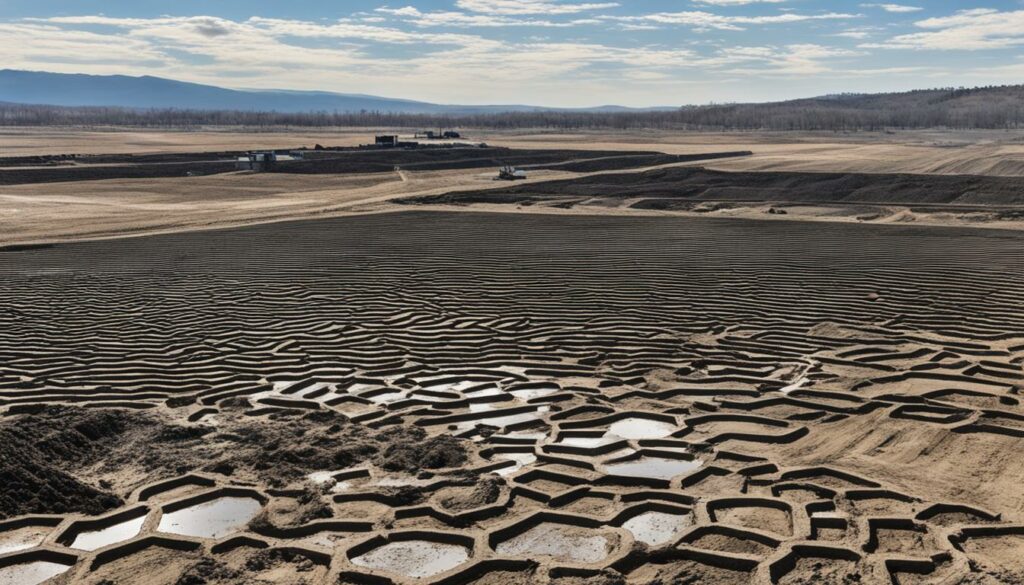
Too many farm animals on the land cause overgrazing. This harms the soil and kills native plants. As a result, the land becomes less productive and more prone to erosion.
Worldwide, land for raising livestock takes up a third of all land. It uses over two-thirds of agricultural land. Clearing forests for this reason leads to the loss of approximately 137 plant, animal, and insect species every day. To protect the environment, we need to control how much animals graze and save plants and trees.
The livestock sector is a big player in greenhouse gases. It’s accountable for 18% of the world’s emissions. Main gases include methane, nitrous oxide, and carbon dioxide.
Methane makes up a big part of animal-related emissions, from animals like cows and sheep. These emissions are about 35-40% of the world’s total methane. Farm animals produce most of the world’s nitrous oxide too. Their ammonia emissions are also significant. Livestock’s carbon dioxide output is very high, producing around 7516 million tons of CO2 each year. This is more than all the world’s transport emissions. It shows we must take strong action to cut down these harmful gases from the livestock industry.
Irrigation has a huge impact on how farmers in local areas operate. It uses 70% of the world’s freshwater, which makes using it wisely very important. Experts think farming will need even more water by 2050 to feed everyone.
There’s a big push for irrigation that saves water around the world. One technique called deficit irrigation uses less water but still grows good crops. It’s now part of efforts to protect our planet by using water smartly in farming.
The link between food, energy, and water (FEW) shows us how much greenhouse gases come from irrigation. This makes finding green ways to use water even more urgent. A study in China shows how national water projects must also help local farmers.
In 2016, over 40% of farmable land was used for growing staple grains like corn and rice. Balancing farming growth with nature’s needs is key. Techniques like moving water virtually, shown by Zhao et al., can help regions with too little water.
“The need to manage water resources sustainably is a priority as the global population increases and agricultural demands rise,” noted Zhao et al. in their 2015 study on regional water stress alleviation through physical and virtual water transfers.
In summary, adapting to new water-saving farming methods helps the planet. By following smart water rules, local farms can keep thriving in a way that’s good for the earth.
In today’s farming, chemical fertilisers are key as the world’s population is expected to top 10 billion. They help grow more food by providing important nutrients like nitrogen, phosphorus, and potassium to plants. These are called NPK.
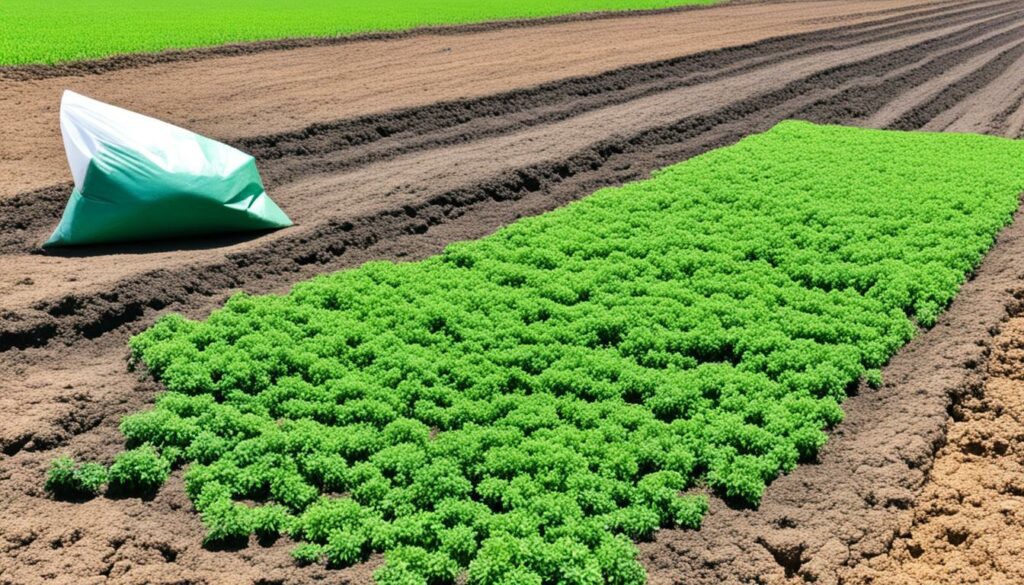
Using chemical fertilisers has huge advantages. They’re behind more than half of all food we eat. In fact, ICL Group’s products feed 175 million people every day. They also prevent forest loss, help the soil and support the UN’s goal for food security.
But, there are big problems too. Too much can harm the environment by adding too much nitrogen and phosphorus. This causes eutrophication and creates dead zones in water. Also, about half of the nitrogen in these fertilisers gets lost, hurting the soil, water, and air.
To counter these issues, we need new ways to farm. This is where organic and precision farming come in. They use natural stuff and better technology to lessen the harm on nature.
ICL’s eqo.x and fertigation are part of these new methods. They help us use fewer resources while farming. This supports the planet by cutting down on water use and matches with goals for sustainable agriculture.
| Benefit | Drawback | Alternative Solution |
|---|---|---|
| Increased food production | Environmental eutrophication | Organic fertilisers |
| Improved soil fertility | Greenhouse gas emissions | Precision agriculture |
| Supports global food security | Nutrient runoff issues | Controlled-release technology |
| Carbon sequestration benefits | Water contamination | Fertigation |
The balance between agricultural growth and ecosystem health is vital today. California, known for its massive agricultural output, is working hard to maintain this while protecting the environment. Its farm irrigation uses more electricity than 1.5 billion homes. Also, over half of the state’s greenhouse gas emissions come from farming. We are seeing the rise of sustainable agriculture to tackle these issues.
Integrated farming systems are crucial for a solution. They mix practices like crop rotation, permaculture, and agroforestry. These not only increase productivity but also help the environment by improving soil, reducing erosion, and supporting more plant and animal life. For instance, enriching soil through organic methods can cut groundwater pollution and other costs of standard farming.
Agroforestry, which combines trees and shrubs with crops, helps store carbon and makes soil better. It fits well with efforts for sustainable agriculture led by CalCAN and similar groups. Agroforestry benefits by boosting ecosystem health and supporting farm growth in a sustainable way.
Conservation agriculture is also making a big difference. This approach focuses on disturbing the soil less, keeping it covered, and growing different crops together. It leads to less runoff, lower greenhouse gases, and more natural variety. These moves prove that caring for the Earth can also help farming grow sustainably.
Furthermore, buying local, like at farmers markets, can aid a lot. In the U.S., food on average travels 1,500 miles to get to people. But at places like the Ferry Plaza Farmers Market, the food only travels about 100 miles. Choosing local means saving resources and cutting greenhouse gases, supporting both local and global environmental well-being.
In short, a mix of integrated farming, agroforestry, conservation in farming, and buying local is key. These strategies link farming growth with nature’s well-being. They’re supported by green policies worldwide, showing a united effort to ensure a healthy planet and productive agriculture.
The link between global environmental policies and local farming is intricate but vital. These policies guide us to ensure we have enough to eat without harming our planet. By using eco-friendly farming and sustainable methods, we can help keep our ecosystems healthy while still growing food.
European countries launched online platforms during COVID-19 to back local food makers. They aim to use less long transport, making regional food systems stronger. Yet, relying too much on local food could lead to shortages instead of preventing them.
Buying from local food systems helps rural areas grow and knits communities closer. It also boosts farmers’ earnings when they sell directly to local markets. Still, flying in food causes a lot of harm to the environment. And local farming may become too much intensive, harming the land.
Finding the right mix to support local foods without causing more problems is key. We need strategies that work both globally and locally. Protecting soil, using fewer chemicals, and saving wildlife are critical. These steps help us look after our food needs and our planet together. This way, we can achieve goals for a sustainable future.
Global green policies affect how local agriculture is done. They push for methods that protect water, soil, and limit use of harsh chemicals. These changes help meet bigger environmental targets.
These policies have shifted farming towards more eco-friendly ways. Things like crop rotation and careful use of pesticides are common now. They help keep the land healthy and farming sustainable.
Modern farming is embracing new technology to meet the demands of green policies. Techniques like precise farming and renewable energy help reduce the impact on our planet. Plus, they make farming more efficient.
Crop rotation boosts soil quality and keeps pests in check. This approach leads to better crop growth over time. It’s a key method supported by international environmental agreements.
Organic farming is good for nature because it avoids nasty chemicals. By going natural, we help the Earth stay diverse and our soils well. This is in line with worldwide efforts for greener food production.
Many eco-friendly farming methods are used globally. Steps like careful tillage, natural pest management, and renewable energy are popular. These steps aim to cut down on harm to the environment.
Water rules aim to use water more wisely on farms. They push for tech and methods that save water. This is crucial to meet the high demand for water in agriculture more sustainably.
Soil policies focus on keeping our land and farms healthy. They try to stop soil loss and keep farming lands fertile. These actions help farms keep producing while following green rules.
To fight heatwaves, farms can change what they grow, pick strong plants, and provide shade. These steps safeguard crops and animals from extreme heat. They show how farming responds to climate threats.
Farmers fight floods by building better drainage and managing land to soak up water. These steps help guard our fields from flood risks. They are part of larger plans to safeguard farm areas from climate changes.
Renewable power, especially from the sun and wind, is changing farming for the better. It cuts down on pollution and helps keep farming going strong. This is key in the global fight for a cleaner world.
Farms are finding smart ways to deal with waste. They compost, recycle, and handle manure well. These methods lessen the farm’s impact on our environment. They’re part of the path to a greener farming future.
Global green rules influence how food is made locally. They push for less travel, more local sales, and support for local economies. This all sticks to high environmental standards.
Green farming rules cut down on chemical need by promoting natural pest control and kinder fertilisers. They aim to keep our soil and water safe. This is vital for a healthy and balanced farming future.
Steps to protect variety in nature include saving places for species to live, keeping many kinds of plants and animals, and growing trees with crops. These measures tie into efforts facing the heart of green farming laws.
Livestock farming can hurt our planet through grazing too much, spoiling soil, and making harmful gases. Using earth-friendly ways is important to make a big difference in how farming affects our world.
How we use and manage water is big for farming locally and globally. Water-saving methods are becoming more common. They help farms stay productive without harming nature as much.
Chemical fertilisers help grow food but bring problems like water pollution and gases that warm our planet. Global efforts are pushing for kinder ways to farm to avoid these issues.
To grow but keep nature healthy, we can combine farming with growing trees, soil-friendly farming, and looking after our land better. These steps support both growth and the environment, meeting big global goals.